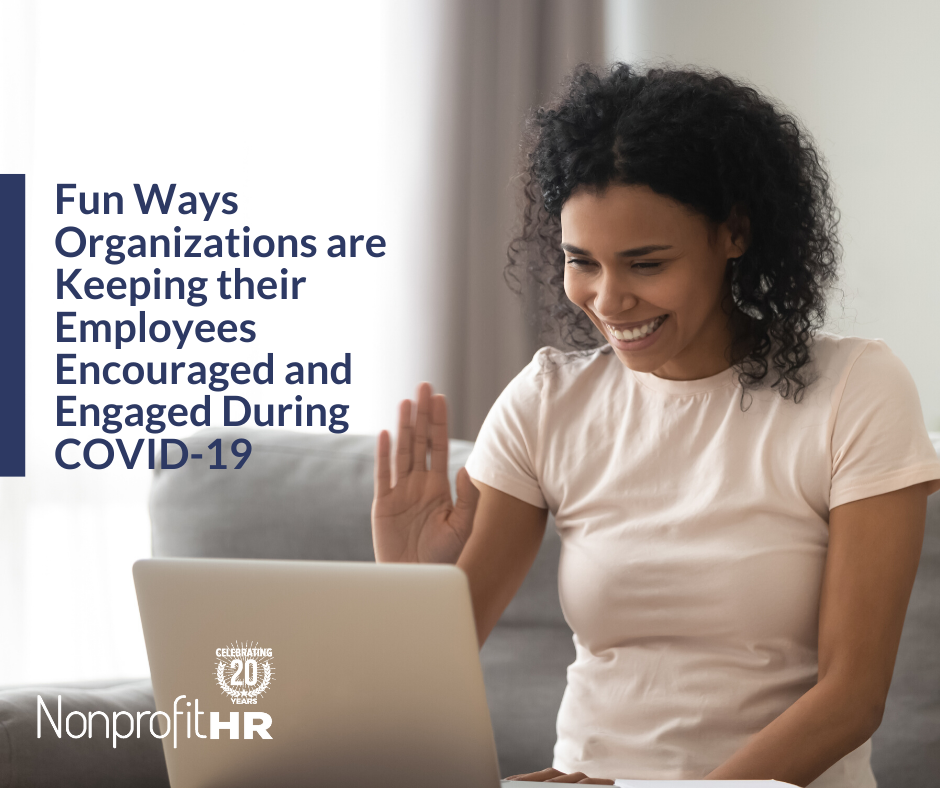WTOP: 5 ways nonprofits can…
The employee performance review as we traditionally know it is often seen as a painful process for everyone involved. Typically, it happens once annually, and employees are given high-level, general feedback on how they’ve performed over the course of the calendar year. One very intimidating version of this annual event, pioneered by GE decades ago, began as a quantitative system built to rank employees and weed out low performers.
The buttoned-up annual review practice worked its way into other companies and eventually into nonprofit organizations, intended as a way to make sure team members were meeting their employers’ expectations and furthering the organization’s success. The focus was on what was best for the organization, not what was best for the employees themselves, leaving workers feeling more disheartened by the process than empowered. Plus, because they only happened once a year and complicated by recency bias, these annual reviews didn’t give the most accurate picture of the employee’s overall performance.
Today, this new generation of workers prefers a much different system for receiving feedback in the workplace. Many, including us at Nonprofit HR, find annual performance reviews to be archaic and no longer meeting our needs as an organization. A whopping 89 percent of employees surveyed by Accenture believe job performance would significantly improve if performance management were changed. Even GE, the past champions of a rigid system of judgment, have shifted away from the agonizing process of traditional annual reviews and have begun to give more frequent feedback to staff, placing more emphasis on coaching instead of critiquing and ranking.
If your organization struggles with the performance review process, there are a few things you can do to improve upon it to create more positive outcomes like higher rates of engagement and retention, employee satisfaction and overall improved performance from all members of your team.
Give more frequent reviews
Instead of the annual or bi-annual reviews that used to be the norm in business settings, implement more frequent and less formal feedback meetings that are more of a conversation than traditional evaluations. Many organizations are already making that change. Of those surveyed by Accenture, 45 percent had shifted to ongoing feedback in the past five years.
At Nonprofit HR, we’ve also abandoned the annual review (and encouraged many of our clients to do the same) and have followed in the footsteps of companies like Zappos and Motley Fool, known for their method of giving continuous, actionable feedback to team members that combines a focus on traits like how passionate or determined they are at work, with a focus on functional competencies. By continuously discussing an employee’s overall cultural fit rather than just how well they’ve performed on individual tasks, the mechanical nature of the traditional review is set aside and employees feel valued and unique–not like just another cog in the wheel.
We recommend that managers hold one-on-one progress meetings with team members at least quarterly to allow their direct reports to get maximum benefit from the review process. As noted earlier, annual reviews are saddled with recency bias. An employee may have made a misstep at some point in the month preceding the review, and that event can cloud the entire year, even if performance was effective leading up to that point, simply because more distant events aren’t at the forefront of the manager’s mind. Once more frequent review meetings are put in place, managers can address more timely and relevant work-related events and behavior, both positive and less positive, and reward or remedy performance in a direct and actionable way.
Not only will your team members feel more confident in their strengths and have a clearer understanding of their weaknesses, but your organization will see the benefits of addressing and adjusting on a more regular basis. More frequent feedback fosters better communication, growth and empowerment for every member of your team and ensures managers are providing feedback to employees more than once a year.
Use multi-directional feedback
It’s not enough for your managers to present a laundry list of areas of improvement to their team members. Feedback can, and should, go more than one way. A manager shouldn’t be immune to the input of the team. To foster growth for every member of your staff, even your managers, we recommend using a multi-directional feedback model.
For a multi-directional feedback model to really work, organizations must create what I like to call a “culture of trust,” meaning the employee and manager must trust each other enough to both share and receive the feedback in a way that is both safe and constructive without either party feeling that the risk for doing so outweighs the benefits. It’s important that, just as an employee is expected to, a manager can receive constructive feedback without attempting to silence the employee’s perspective or become angry with the employee if they happen to disagree. Trust based environments make it clear that both managers and staff perspectives have value, that both parties have the opportunity to express themselves and that their opinions will be taken into account.
In order to create this type of environment in your organization, it may be valuable to train managers to not only effectively give feedback, but to receive it.
For organizations that want to foster feedback beyond the employee-manager dynamic, multi-rater or 360 degree reviews can provide an incredible amount of feedback and insight into effective and ineffective workplace behavior and performance.
With a more holistic, 360 degree view of your nonprofit’s team, in which it’s clear where each employee’s strengths lie and how each individual could possibly improve his/her performance, your organization will be better positioned for success.
Plus, once your employees can express their own ideal work and professional development needs, they will be more likely to connected to and engaged with your organization. Deeper levels of engagement drive improvements in employee retention and build a desire to progress within your nonprofit rather than outside of it.
Instead of focusing on the past, focus on professional development and look to the future
Your managers may look at reviews as an exercise in critiquing past performance, but what your employees really want to walk away with is more opportunity for professional development and a discussion about the future. According to employees at organizations large and small, professional development opportunities are not given enough attention in the performance management process. In fact, 65 percent of employees surveyed by Accenture believe that “performance management practices are still often about top-down control—and are focused on assessment of the past rather than development for the future.”
Commit to bucking this trend by giving employees in your nonprofit opportunities to grow and providing the tools staff need to meet their own personal goals as well as your organization’s. As a part of this shift, offer your employees the opportunity to set and work toward goals that aren’t directly tied to their compensation, and make those goals an important part of your performance management process. Pay can be an incentive to achieve certain goals, but it shouldn’t be the only one.
In a similar vein, try to avoid using compensation as your primary tool for rewarding your employees’ past performance especially if you are not able to compensate your high performers and your low performers differently. If someone who consistently demonstrates top performance receives a 3% increase and the employee who shows up to work every day but whose performance is less than average, receives a 2.5% increase, your compensation practices really aren’t rewarding great performance. Find other methods for showing your appreciation for a job well done, such as public praise, or formal employee recognition programs like Kudos. By loosening the tie between past performance and pay, you’ll open up opportunities to compensate your staff based on what they’re capable of doing in the future and what they would like to achieve, not just what they’ve achieved thus far.
Set benchmarks and outline for your employees what the next step up looks like for them. Gauge their interest in meeting those benchmarks in the future, as well as how they envision their future within your organization. If your employees feel that their own growth and development is as important as the growth and development of the organization itself, they will be more likely to want to continue to be a part of your team for the long haul.
We understand that making changes to your current internal performance review processes won’t happen overnight. It takes time and preparation to create the right performance management system—and some trial and error to learn what works best for you and your team.
Spend some time preparing to get a new performance feedback program up and running now, knowing that the process will require significant planning and buy-in from staff and management at all levels. Here are a few things you can do early on to determine the best next steps for your organization:
- Evaluate your current review process and take note of exactly where you think you can improve and where your process could potentially remain as is.
- Ask your employees how and when they would prefer to give and receive feedback.
- Gauge management’s readiness to hear performance feedback from their direct reports. Consider providing training in this area. If management is not ready, press pause on upward feedback.
- Try changing one element of your performance management process at a time. With each change, reassess how employees are responding to make sure the change is in line with your organization’s mission, goals and values before you move onto the next modification.
And, of course, if you ever need any assistance with your nonprofit organization’s performance management, professional development or other human resources needs, please don’t hesitate to contact us. Nonprofit HR has practice areas focused on performance management, learning & development, compensation and more.





























